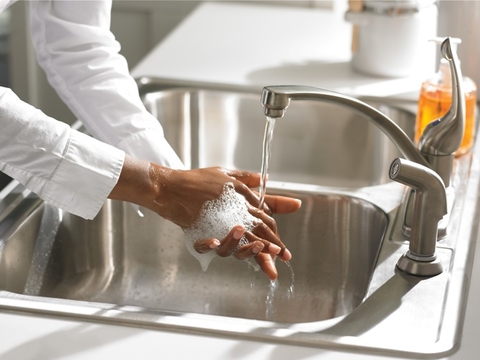When preparing or serving food, you have a very important job in providing safe food for family and friends. Use correct kitchen habits and learn to practice good personal hygiene. Dirty kitchens, bad personal hygiene or careless food handling can carry bacteria that infect food and cause foodborne illnesses.
See why it's important to wash your hands before you put on gloves to prepare food.
The fives Ws of handwashing
The five Ws of handwashing are the who, what, where, when, and why. These, along with the how, will minimize the risk of spreading pathogens to food and your customers.
Who
You and anyone working at your stand must perform frequent handwashing. This includes anyone who is touching, preparing or serving food, handling money or credit cards, or completing sanitation activities.
What
Proper handwashing includes washing your hands, wrists and any part of your lower arms that are exposed. Special attention should be paid to scrubbing under nails and between fingers as pathogens can easily hide here. Prosthetic devices should be washed following the same handwashing procedures.
Where
Keep your handwashing station clean and stocked during the entire event.
When
When handling food, it is important to wash your hands before beginning work and whenever your hands may become contaminated.
Wash your hands before:
- Preparing food.
- Packaging food.
- Beginning a new task.
- Putting on disposable gloves.
Wash your hands after:
- Using the toilet (wash your hands at the restroom facilities and again when you return to your stand).
- Handling raw meat, poultry, fish, eggs and uncooked flour.
- Touching pets and animals.
- Eating or drinking.
- Smoking, vaping or chewing tobacco.
- Coughing, sneezing or blowing your nose
- Touching your hair, face or body.
- Handling trash, recycling and organics.
- Cleaning and sanitizing.
- Using a phone or electronic device.
- Shaking hands or hugging.
- Handling money or credit cards.
- Any time you leave the food production space and return to food handling.
- Any time your hands become contaminated.
Why
Handwashing with warm water and soap removes up to 92% of pathogens from hands. Drying your hands with a single-use paper towel can remove additional pathogens.
How
The handwashing process should take 20 seconds.
- Turn on the water spigot.
- Wet hands with warm water.
- Apply enough soap to work into a lather.
- Scrub hands together for 10 to 15 seconds. Rub palm to palm, palm to back of hand, interlace fingers, grip thumbs, fingernails to palms, up wrists and lower arms.
- Rinse under running water.
- Dry hands with a single-use paper towel.
- Turn off the water spigot with a paper towel to prevent re-contamination.
- Discard paper towel into waste receptacle.
Hand sanitizers (liquids, gels or wipes) are not a substitute for handwashing. Hand sanitizers do not remove dirt or grease from hands which decreases their effectiveness for inactivating any pathogens. Hand sanitizers can be used after handwashing to inactivate any remaining pathogens.
Dipping or rinsing your hands in warewashing soap and sanitizer is not proper handwashing.
Single-use disposable gloves are not a replacement for handwashing. Proper handwashing must be used before putting on single-use disposable gloves and between changing gloves.
Reviewed in 2024


